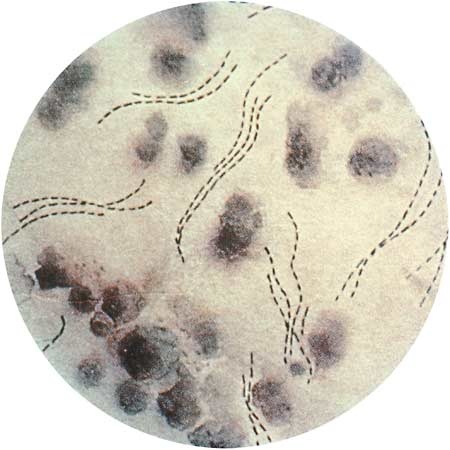Haemophilus
bacteria genus
also spelled Hemophilus,
 genus of very small rod-shaped bacteria of uncertain affiliation. All species of Haemophilus are strict parasites occurring in the respiratory tracts of warm-blooded animals, including humans, and in certain cold-blooded animals. All Haemophilus are gram-negative, aerobic or facultative anaerobic and nonmotile and require a growth factor that is found in blood. They are minute in size, H. influenzae measuring 0.3 micrometre across and up to 2 micrometres long.
genus of very small rod-shaped bacteria of uncertain affiliation. All species of Haemophilus are strict parasites occurring in the respiratory tracts of warm-blooded animals, including humans, and in certain cold-blooded animals. All Haemophilus are gram-negative, aerobic or facultative anaerobic and nonmotile and require a growth factor that is found in blood. They are minute in size, H. influenzae measuring 0.3 micrometre across and up to 2 micrometres long.H. gallinarum causes infectious coryza in fowl. H. parasuis (itself not disease-causing), together with a virus (Tarpeia suis), causes swine influenza. H. ducreyi causes a venereal disease in humans known as chancroid, or soft chancre. H. influenzae was at one time thought to cause human influenza, but it is now believed to be a source of secondary infection in persons suffering from influenza, which is now known to be a viral disease.
- Gideon Welles
- Gielgud, Sir John
- Gierek, Edward
- Gierke, Otto Friedrich von
- Giers, Nikolay Karlovich
- Giesebrecht, Wilhelm von
- Gieseking, Walter
- Giessen
- GIF
- Gifford, Edward W.
- Gifford Pinchot
- Gifford, William
- gift
- giftbook
- gifted child
- gift exchange
- gift of tongues
- gift tax
- Gifu
- gig
- gigaku mask
- gigantism
- Gigantopithecus
- Gigli, Beniamino
- Giglio Island